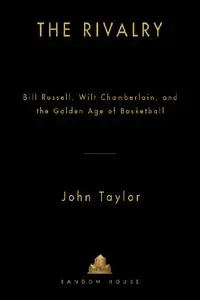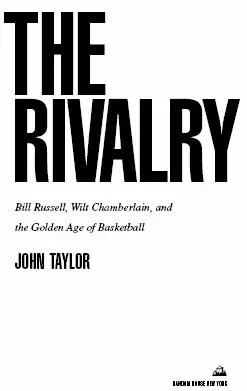The Rivalry: Bill Russell, Wilt Chamberlain, and the Golden Age of Basketball


Contents
Cover page
Title page
Dedication
Chapter 1
Chapter 2
Chapter 3
Chapter 4
Chapter 5
Chapter 6
Chapter 7
Chapter 8
Chapter 9
Chapter 10
Chapter 11
Chapter 12
Chapter 13
Chapter 14
Chapter 15
Chapter 16
Chapter 17
Chapter 18
Chapter 19
Chapter 20
Chapter 21
Chapter 22
Chapter 23
Chapter 24
Chapter 25
Chapter 26
Endnotes
Notes
Bibliography
Acknowledgments
About the Author
Also by John Taylor
Copyright
To my father,
for always insisting on fair play
1
ON THE NIGHT of November 7, 1959, people lined up on the sidewalks outside Boston’s North Station, a dingy yellow-brick building, and crowded along the bar at the Iron Horse, the old drinking-parlor inside. They stood in clusters on Causeway Street and Haverhill Street and Canal Street, their voices almost drowned out by the thundering traffic on the elevated highways and subway tracks that crossed above them on iron girders, and by the hiss and clang of the trains in the rail yards.
The citizens of Boston had much to debate that evening. In Washington, D.C., Charles Van Doren, the thirty-three-year-old Columbia University English professor, had just admitted to a congressional committee that the producers of Twenty-One, the television quiz show that had turned him into a national icon, had been secretly prepping him with the answers to questions. Senator John Kennedy, who had all but announced his intention to run for president the following year, had been touring California and Oregon the previous week, greeted by ecstatic crowds carrying signs saying “Viva Kennedy!” In Boston itself, a newspaper strike was under way, and just four days earlier, John Collins, the Suffolk County register of probate and a victim of paralytic polio who was confined to a wheelchair, had defeated Senate president John Powers for the Boston mayoralty. It was a stunning upset, brought about by an FBI raid on the headquarters of a gambling syndicate just one hundred yards from the East Boston police station and resulting in charges of widespread corruption in the city’s government.
But the topic that consumed the crowds around North Station was neither the television scandal nor the impending administration of John Collins nor the presidential prospects of a young Irish American Catholic. It was instead basketball, specifically the game scheduled that night between the Boston Celtics and the Philadelphia Warriors. While Boston was a storied sports town, the sports that had always provoked the most passion were baseball and hockey, the sports of the Red Sox and the Bruins. These were sports with rich local histories, sports that had been played for generations in Boston and had, over the years, woven themselves so deeply into the fabric of the city that residence there seemed virtually synonymous with a rabid devotion to its baseball and hockey teams. Professional basketball, in contrast, was only thirteen years old in 1959. Walter Brown, the owner of the Bruins and leaseholder on the Boston Garden, had started the Celtics to fill seats at the arena on nights when his beloved hockey team was not playing and the big, drafty building, located above the train station, would otherwise sit dark and empty. In other words, the team was a purely commercial afterthought in a sport without strong roots in the city’s culture, and for much of the fifties, attendance at its games reflected this. Rarely was the Garden more than half filled on the nights it played. Members of the Celtics joked that while Ted Williams could not get out of a car on Charles Street without being mobbed, their entire team could walk the length of the Common and no one would give them a second glance.
On the night of November 7, however, every one of the 13,909 seats in the Garden had long been sold out, even the hundreds of seats whose views became partially obstructed when the hockey arena was converted to a basketball court by raising the backboards, running guy wires out to the sides, and bolting the wooden parquet squares to the subflooring. Outside, along Causeway Street, scalpers were demanding upwards of $20 for tickets that usually went for $2.50. One New York sportswriter, arriving at North Station earlier that afternoon, was offered a ticket for $10 by a scalper who told him, “Just trying to do you a favor, Mac. I can get more for it at the Garden just before game time.”
The reason for the excitement was that twenty-three-year-old Wilt Chamberlain had joined the Philadelphia Warriors as a rookie that year and on this night Chamberlain would for the first time face the Celtics center, Bill Russell. The game was so eagerly anticipated that Red Auerbach, the Celtics coach, had been telling people that it would draw enough fans to fill Yankee Stadium. Sportswriters were calling the confrontation Battle of the Titans, Battle of the Giants, and Big Goliath vs. Little Goliath. They were speculating about what would happen when an “irresistible offensive force” encountered an “immovable defensive object.” In an article anticipating the game, Sport magazine’s headline was “The Big Collision,” and it declared, “Pro basketball will be stepping into its golden age when Wilt Chamberlain, the rookie, clashes with Bill Russell, the leaping veteran.”
Chamberlain had attracted national attention even while a student at Overbrook High School in Philadelphia, where his team won fifty-eight games and lost three in his three years there and where he set a statewide scoring record, averaging just under forty points per game. At the University of Kansas, he had proved to be such an overwhelming presence on the court that Jimmy Breslin, then a young sportswriter, wrote an article for The Saturday Evening Post entitled, “Can Basketball Survive Chamberlain?”
Basketball had had big men before. In the early fifties, George Mikan, the six-foot-ten-inch center of the Minneapolis Lakers, had dominated the game. But Mikan was a lurching, graceless man who wore metal-rimmed glasses and lumbered up and down the court, bashing aside opponents with his huge left arm. Chamberlain was more than seven feet tall and wore size fourteen-and-a-half shoes, but he was also quick, agile, strong, and smart. His legs were so long that he seemed part gazelle. And they were so powerful that when he leaped up, arms raised, toward the backboard, his hands at the apex of his jump were three feet above the rim, which he could look down into. He was so good that not only did no one seem to be able to beat him, few people seemed actually capable of playing against him.
Except maybe Bill Russell. Russell had led the Celtics to two championships since joining the team three years earlier. Never much of a shooter, Russell had nonetheless perfected a style of defensive play, blocking shots and rebounding ferociously by leaping so high into the air that he seemed to hang there in suspension. His size and athleticism had literally transformed professional basketball.
1 comment